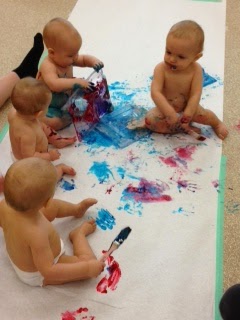Often, when we think about teaching children to read, we focus on their knowledge of letters, letter sounds and what we call "decoding," or a child's ability to use letter-sound relationships to pronounce words they see in writing.
These skills are important-- in fact, knowledge of letter-sound relationships and decoding skills are predictive of reading success in first grade.
But it isn't the strongest predictor of reading success after 3rd grade-- but why not?
Something switches for children around the 3rd or 4th grade. They move from
learning to read to
reading to learn. It's a key difference!
And what's the strongest predictor of reading success in those later elementary grades? Vocabulary. (Hemphill and Tinvan, 2008.)
 |
| Children study a car's motor. Lots of new words to learn! |
But why? Before 3rd grade, children spend much of their time learning to decode very simple text. Vocabulary and having broad knowledge doesn't matter much. But after 3rd grade, comprehension is king, and the key to being a strong reader. According to University of Virginia professor, Dr. Daniel Willingham, author of the 2015 book,
Raising Kids Who Read, good readers are "people who know a lot." This is because, in part, comprehension of written texts involves a lot of inference on the part of the reader. Authors leave out the knowledge they assume the reader already knows (otherwise, reading becomes tedious.) Without a broad knowledge of the world, children are very challenged when deciphering the meaning of the text because they're unable to draw on that "missing" information.
How do we help children build their vocabularies? Clearly, building a large vocabulary takes time, so we can't wait until 3rd or 4th grade to do it! At the YCCF, we offer children a variety of experiences to help build their vocabularies. When a preschool class studies insects, they may invite an
entomologist to come talk to the children. When learning about shapes, we might investigate not only circles and squares, but
octagons and a
rhombuses. When participating in art experiences, we might talk about not only purple and blue, but also
magenta, aquamarine and turquoise. When building towers in the block area, teachers might bring up ideas about
architecture and blueprints, and describe block buildings as not only tall, but also
gargantuan, towering or colossal. You'll be surprised at how quickly children adopt these new, but meaningful, vocabulary words as their own.
How can you help your child's vocabulary grow at home? Talk, talk, talk, and not just
to them but
with them. Give them all kinds of experiences-- there are so many to be had right here in our own community. Visit the library and meet the librarian to learn new vocabulary related to books. Visit our state parks or a nature centers to learn lots of new vocabulary words related to nature. Go to the grocery store and learn all about the fancy kinds of fruits and vegetables that you might not eat everyday. USE new and bigger vocabulary than you think your child would normally use. Introduce it to them in natural ways that connect the new words to their current knowledge. "Your block tower is so tall! It's colossal!"
Interested in learning more?
Here's some research and
Here's the book, Raising Kids Who Read by Dr. Willingham.
What "big words" will you introduce to your child today?







